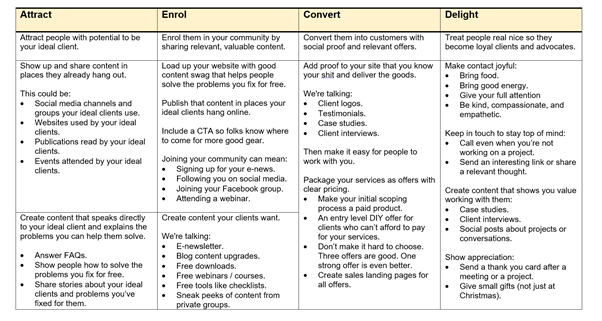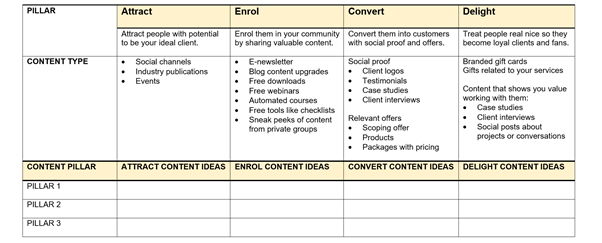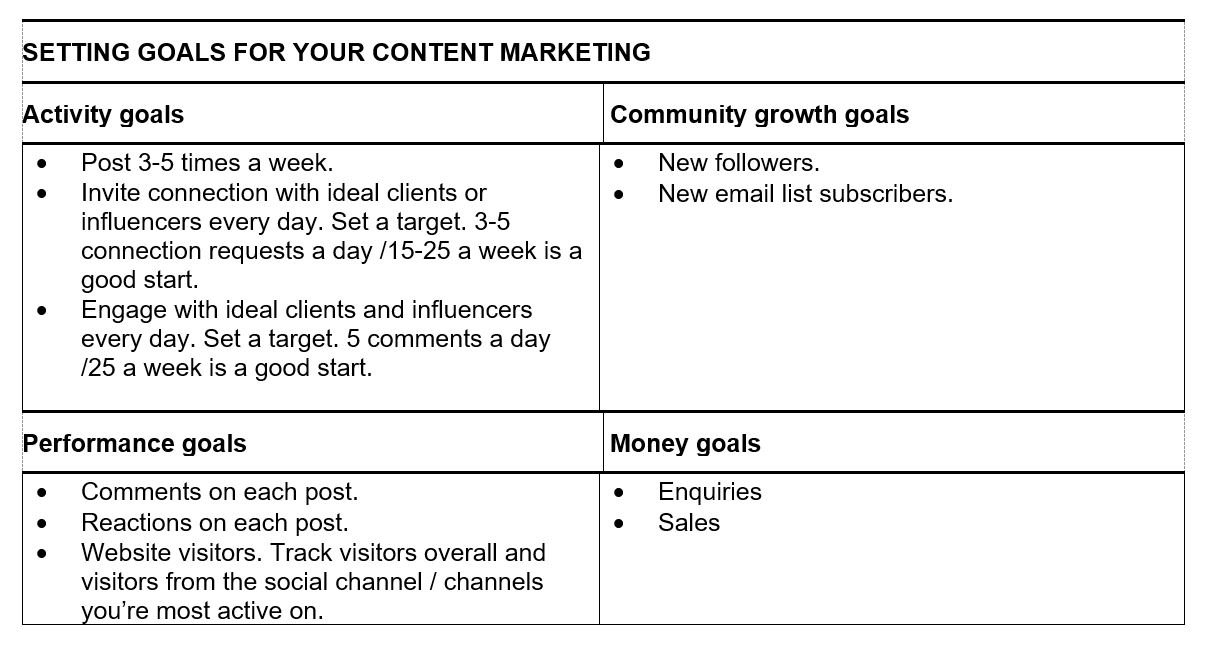A guide for consultants, coaches, and freelancers
If your content marketing has been a bit hit and miss, not the source of leads and love that you hoped, it’s probably because you haven’t got yourself a solid plan underpinning your content efforts. Read on for a simple five step content strategy refresher for consultants, coaches and freelancers.
What is content marketing?
Content marketing is the practice of creating, publishing, and sharing content to promote your business. This content can take the form of social media, blog posts, articles in industry publications, educational resources, videos, podcasts, webinars, or presentations.
Content marketing is based on the theory that the best way to attract your ideal clients is to create content that helps them fix the problem you solve for them for free.
Instead of making your marketing all about you and what you have to sell, you make your marketing all about your ideal client, and what they want to achieve. Content marketing is a generous client-centric approach to marketing where you give away your knowledge and advice, and in return you gain trust, kudos, and business growth.
When you get content marketing right, it shows that:
You understand your ideal client’s challenges and goals.
You’re an expert in your field.
You’re knowledgeable and generous to work with.
Who is content marketing for?
Content marketing is highly effective, But it’s not for everyone.
Content marketing is the right business development strategy for you if you:
Enjoy creating content.
Enjoy engaging with people online.
Dislike cold calling and direct selling.
Can commit to consistent activity.
Can take a long-term view of your business and invest in a marketing strategy that’s a slow burn to start but gathers momentum over time.
It won’t work for you if:
You want instant results.
You’re obsessed with attributing revenue directly to marketing activity. Content marketing has a cumulative effect. It’s rare you can attribute $$$ directly to a particular piece of content.
Content marketing is ideal for consultants, coaches, and freelancers because your personal brand, your personality, reputation, and expertise, is central to the success of your business. Creating and sharing content helps build your personal brand, attracting your ideal clients to you.
I’ve used content marketing to grow my own six-figure copy writing consultancy in under two years. I get to work with clients I enjoy and admire, I do work I love, and I never have to go hunting for business. It comes to me. But this hasn’t happened by accident. It takes consistent effort and a plan.
Why do you need a content strategy?
Making content marketing work for you starts with a clear, considered content strategy.
Why do you need a content strategy? Why can’t you just write whatever you fancy?
If you go on LinkedIn, you’ll see plenty of people doing exactly that, writing whatever they feel like that day. But most of those people will not be seeing much, if any return on the time they spend creating that content. Sure, they may get likes and comments, but they won’t be getting business and opportunities.
And I’m not here to teach you creative writing. I’m here to teach you how to use content as a tool to build your personal brand and grow your business. So, your content needs to be purposeful.
Purposeful content sets out to achieve a clear purpose for a specific audience.
Every time you lay fingers to keyboard you want to be sure that you know:
Who you’re writing for.
Why you’re writing.
What you want people to do.
A clear, considered content strategy makes sure that you do just that.
A simple content strategy for consultants, coaches, and freelancers
When I coach consultants and coaches on content marketing, or create content strategies for my clients, I use a simple five step content strategy process.
Step 1: Know who you serve and the problem you solve for them
Until you know this, all your content creation is simply pissing into the wind, and hoping some of the drops make it to the urinal.
Step 2: Understand how content drives your customer journey
Understand the stages of customer awareness and the principle of creating content for each stage so you meet potential clients where they’re at.
Step 3: Create your own content strategy
Align content pillars to the services you offer.
For each pillar, brainstorm ways you can teach people to fix the problems you fix for free.
Align content ideas to each stage of awareness for each content pillar.
Step 4: Set goals and measure success
I measure content marketing four ways:
Activity goals
Community growth goals
Performance goals
Money goals
Step 5: Do more of what works and less of what doesn’t
And that’s it. It’s not easy. But it’s simple.
Let’s look at each step in more detail, so you can use this process to plan a content strategy that’ll grow your business.
Know who you serve and the problem you solve for them
I’ve written about the importance of knowing your target market elsewhere, so I won’t go into great detail here. But to summarise, identifying your niche helps you:
Hone your messaging to be more relevant to a specific group.
Target your marketing. Unless you’ve a budget of squillions you can’t market to everyone.
Reduce your competition. There are a lot of generalists out here, but not many specialists. Stake a claim and own your market.
Become first choice for your target market, because you’re best at solving their problems.
Improve your conversion rate, because it’s easier for your niche to see how your advice and services benefit them.
And when it comes to content marketing, knowing who you’re talking to helps you understand the problems you solve for them, focus your content on topics that help them solve those problems, use language and messaging that resonates, and illustrate the points you’re making with relevant real life examples.
Know who you serve and the problem you solve for them.
Understand how content drives your customer journey
People move through stages of awareness to become your client. Marketers call this your customer journey. You can use content marketing to encourage people to go on that journey from complete stranger to loyal customer.
People start out as strangers, who don’t know you, or what you do. They may not even be familiar with the service you offer. But if you share content that solves their challenges and meets their goals, they can see your service is relevant, and you’re experienced helping people like them.
At each stage of their customer journey, your potential clients have different content needs. A strong content strategy considers the various stages of awareness people move through to become your client, their informational needs at each stage, and plans content to meet those needs.
Here’s how you can create content to match your clients’ stages of awareness.
Create your own content strategy
Once you understand the stages of customer awareness and the principle of creating content for each stage, you can use this customer journey as the framework for a content strategy that increases the likelihood of attracting people who match your ideal customer profile and converting them into loyal clients.
Choose content pillars that will grow your business
The first stage of designing your content strategy is to identify your content pillars. A content pillar is marketing lingo for a topic you create content about frequently to build up a substantial body of content that establishes your expertise.
As a consultant, coach or freelancer, you sell services, so it makes sense to create content that establishes your expertise in these areas. The simplest way to identify your content pillars is to align them to the services you offer.
If you only offer one service, this strategy won’t work for you. So instead identify three-five expert topics you can talk about confidently that:
Help your clients solve their problems and achieve their goals.
Support the service that you offer.
These expert topics then form the basis of your content pillars. I recommend adopting three content pillars to build the basis of your content strategy.
Brainstorm content topics for each content pillar
For each content pillar, brainstorm topics relevant to your ideal client. Your goal is to use your content to teach people to fix the problems you fix for free.
Consultants sometimes get freaked out when I say this and object in two ways.
“But why would someone hire me to do work for them if I share my process for free?”
“But my competitors will know how I do things and copy my IP.”
Neither of these concerns are valid.
Celebrity chefs publish recipe books that share their signature dishes, but they still have waiting lists for their restaurants, because there’s a significant difference between knowing how to do something and finding the time to do it or getting the results an experienced professional will deliver.
And as for IP, if you’re a leader in your field, come to terms with the reality people will try to copy you, and that’s ok. Because even if competitors replicate your processes step by step, they may not deliver the same results and they still won’t be you. People don’t just buy outcomes. Which is a good thing, because if we’re honest, we have to admit plenty of other consultants deliver equally good outcomes. Our clients also buy our personality and experience, and competitors can’t copy that.
So, sit down and brainstorm a bunch of topics for each content pillar. I like to come up with at least 26 topics to start with, so I’ve six months content ready to crank right away. If you’re feeling it, and the ideas are flowing, go for 52 topics and get a plan in place for a full year.
While you’re coming up with content topics remember to share your own stories. Personal insights help potential clients build a relationship with you. People feel like they know you before they meet you and that builds trust and comfort.
Align content ideas to each stage of awareness for each content pillar
Once you’ve brainstormed 26-52 content topics, it’s time to align content ideas to each stage of awareness for each content pillar. Grab a copy of the worksheet I use to do this below.
The main difference between Attract and Enrol content is that Attract stage content is designed to be shared outside your digital community, while Enrol content is for people who are already aware of you and want to dig a little deeper. In both phases, you’re addressing problems your ideal clients experience, and showing them how to fix those problems for themselves.
So, smart consultants start by creating valuable long-form content that enrols people in their community and repurposing that content in bite-size chunks for the Attract stage.
This process can look like this:
Write a substantial article, for example a how to guide including examples, advice and actionable takeaways.
Break that article up into 5-10 social posts.
Post daily on your social channel of choice.
Put a call to action in every post. This can be a call to conversation, or it can be a link to your e-newsletter sign up.
Once you’ve finished posting on this topic, link to the original article to drive traffic to your site. You can also repurpose this content for an e-newsletter.
People move through this customer journey in different ways and at different speeds.
Someone in urgent need of your help goes to your site, sees you offer the service they want, notes you’ve a strong track record and that they can afford your services. Boom. You’ve a new client. Other people may spend years following you on social before they decide to work with you.
Both are great outcomes, so you want to be sure your content marketing caters to both types of potential client. And by aligning content ideas to each stage of awareness for each content pillar you’re ensuring you provide all the information they need to become your client.
Here’s an example of a content pillar from my own content strategy to show you how this works.
Set goals and measure success
Creating, publishing, and sharing content is an investment of time, energy, and money. So, you want to be sure it’s delivering results.
I use four ways to measure content marketing:
Activity goals
Community growth goals
Performance goals
Money goals
Money is the bottom line. You’re in this to grow your business.
Here’s a breakdown of how to set goals for each area.
Measuring results helps you do more of what works and less of what doesn’t, so over time your content marketing efforts become more effective.
How’s your content marketing strategy?
If your content marketing has been a bit haphazard, and lacking in return on investment, the first thing to do is make yourself a solid plan. This guide will help you do that.
If you’re struggling to find the time, and you’d like some help to plan your content strategy, I’m here to help. For a frankly absurdly affordable fee, I can help you develop a content strategy that’ll elevate your content marketing to the next level and get you more enquiries from your ideal clients.






